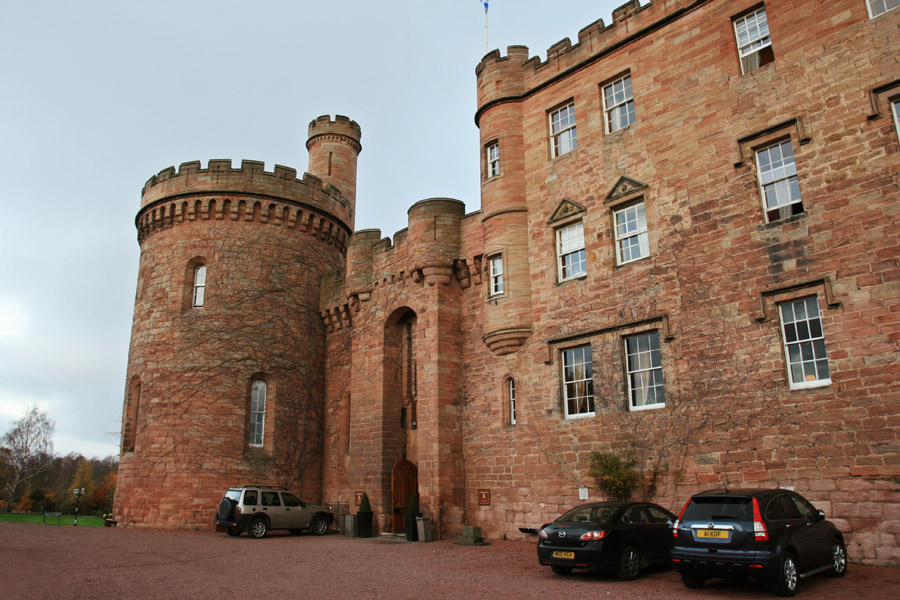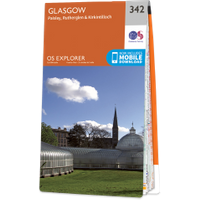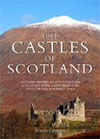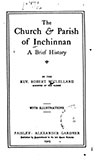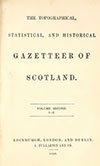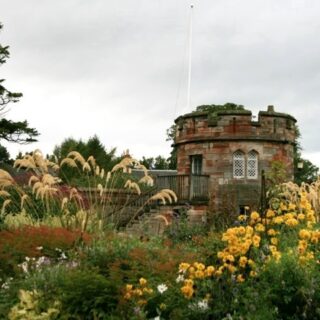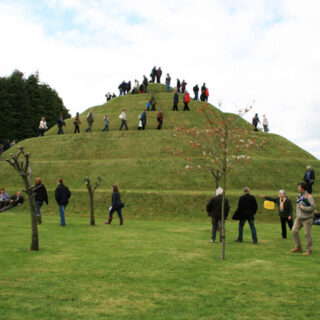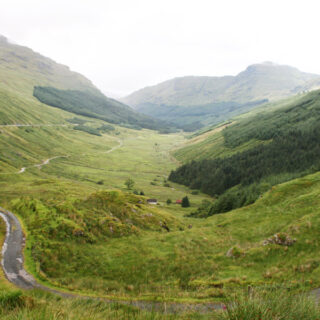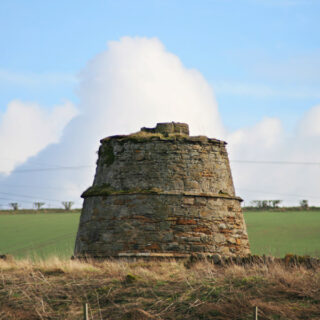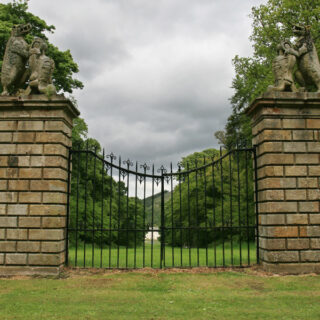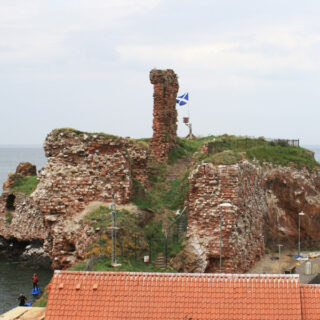Inchinnan Castle (site of)
Inchinnan Palace or Castle was a property of the Stewart Earls of Lennox but nothing of it now remains.
Around 1150 Walter fitz Alan was appointed hereditary High Steward of Scotland by David I and granted the lands of Mearns, Strathgryfe (now encompassing the majority of Renfrewshire), Renfrew, which included Inchinnan, and North Kyle.
Walter gave various lands to his friends and followers including one of his vassals, Sir Robert de Croc of Neilston, who was granted the lands of Crookston around 1170.
It would seem that the Croc family were granted Inchinnan as in the 13th century Inchinnan was part of the lordship of Darnley and Inchinnan, which, along with Tarbolton, was a part of the regality of Crookston owned by Sir Robert Croc.
Towards the end of the 13th century Inchinnan seems to have passed from the Croc family to the Stewarts, later Earls of Lennox.
In 1361 Robert, 7th High Steward, confirmed Sir John Stewart of Darnley, Lord of Crookston, in the lands of Croikisfow, Inchenane and Perthaikscott which John, Steward of Kyle, had resigned. Sir John was the High Steward’s baron-bailie, responsible for administering the barony of Renfrew.
On the 18th of January 1511 Matthew, 2nd Earl of Lennox, obtained for his good service a confirmation from the King of the charter granted by the High Steward of Scotland to Sir John Stewart in 1361. This charter granted him the lands of Croikisfow, Inchenane and Perthaikscott along with the castle and fortalice of Crokisfow, the manor and palace of Inchenane and the lands of Dernlie, the twenty pound lands of Dormondside, Nethirtoun and Ald-Crukistoun of old extent amongst others. The following day his eldest son, John, married Elizabeth Stewart, daughter of Sir John Stewart of Balveny, 1st Earl of Atholl, and Eleanor Sinclair, daughter of William Sinclair, 3rd Earl of Orkney.
Following the death of the 2nd Earl at the Battle of Flodden in 1513 some of his possessions seem to have passed to Sir James Hamilton of Finnart, a grandson of the 1st Lord Hamilton, before being granted by the King to others. The 2nd Earl was succeeded by his son, Sir John, who in 1521 was bailiff of the barony of Renfrew.
Sir John attempted in 1526 to rescue the young James V from the influence of the Douglases but died in the ensuing Battle of Linlithgow Bridge and was succeeded by his 9 year old son, Matthew. In 1532 the late Earl’s widow sent Matthew and his younger brother, John, to their kinsman Robert Stewart, 4th Lord of Aubigny, in France where they joined the Garde Écossaise. Aubigny was the brother of the younger Stewarts’ grandfather, the 2nd Earl of Lennox. Before they left Matthew received a grant from the King of Crukiston, Crukisfew, the lands of Darnley and others.
While the 4th Earl was in France James V continued to grant lands that had been resigned into his hands following the death of the 2nd Earl. In July 1532 John Semple of Foulwod was granted various lands in the lordship of Crukisfe and Inchynnane.
Following the death of James V in December 1542 the Earl of Lennox was encouraged to return to Scotland by Cardinal David Beaton to rival his fellow claimant to the throne, James Hamilton, 2nd Earl of Arran. Both claimed descent from Mary Stewart, daughter of James II. When Lennox arrived at Dumbarton Castle in March 1543 Arran had just been appointed Regent to the infant Mary, Queen of Scots, and declared next in line to the throne.
The Regent Arran sought to marry Mary to Edward Tudor, the son and heir of Henry VIII of England however Lennox was part of the pro-French faction opposed to this. Lennox had been lured to Scotland partly by the prospect of marrying Mary’s mother, Mary of Guise, widow of James V. However in 1544 he married Margaret Douglas, daughter of Archibald Douglas, 6th Earl of Angus, and Margaret Tudor, wife of James IV and sister of Henry VIII.
As part of the marriage settlement he endowed his wife in the lands of Glenrinne, Balloch and Auchintorlies in the Earldom of Lennox, the baronies of Cruckisfew, Inchinnan and Craig of Nielston in the lordship of Darnley and the lands of Erere in Perthshire.
That year Dame Helen Stewart, Lady Erroll, the widow of William Hay, 6th Earl of Erroll, and the eldest daughter of John Stewart, 3rd Earl of Lennox, was described as the proprietrix of the lands of Crookistoun and the lands of Inchinnan in a dispute with Robert Sempill, 3rd Lord Sempill, regarding the corn from those lands.
The 4th Earl was forfeited and exiled in 1545, settling in England on an estate given to him by Henry VIII. In October of that year the Crown granted to Robert Sempill, 3rd Lord Sempill, the lands of Cruikestoun, Dernlie, Neilstoun, Kowglennis, Pottertoun, Dikkonisband, Kowanoris, Glanderstanis, Helfeild, Crukisfie, Neilstounissyde and Inschynnane, with the castles, towers and fortalices, which Matthew, Earl of Lennox, had forfeited.
In May 1546 the Crown granted the castle and fortalice of Crukistoun to the 3rd Lord Sempill and his heirs for good service, and in April 1548 he and his heirs received a further grant of the lands of Crukistoun, Crukisfee, Neilstounside and Inschynnane, with the castles, towers and fortalices.
Mary created her half-brother, John Stewart, Commendator of Coldingham, Lord Darnley in 1562 and granted him a portion of the Darnley estates following his marriage to Janet Hepburn, sister of James Hepburn, 4th Earl of Bothwell.
Lord Darnley died in November 1563 and was succeeded by his infant son, Francis Stewart, whom Mary granted the lordship of the Enzie, the forest of Boyne, Cruckstoun, Inchinnan, Neilstoun and others. However in October 1564 the 4th Earl of Lennox returned to Scotland and was restored in his estates and titles by Mary who provided him with lodgings in Holyroodhouse.
In 1570 the 4th Earl of Lennox was appointed as Regent for his grandson, James VI, and in the same year an inventory of the Place of Inchynnane was produced.
Lennox was shot and killed in a skirmish in Stirling the following year and the Earldom of Lennox returned to the Crown before James VI made a new creation of the title for the 4th Earl’s younger son, Charles, the King’s uncle. Charles and his heirs were granted the lands of Crokisfow with castle, tower, fortalice and mill, the lands of Inchennane with the manor and palace, the lands of Perthaikscot with the mill, together with their tenants. Also the castle of Cruikisfow, the mains lands of Dernlie, the lands of Dormondsyd, Nethirtoun and Auld Cruikstoun (the 20 pound lands of old extent), the manor and palace of Inchennane and the mains lands of Inchennane, for which he was expected to pay the King a single silver coin at the castle of Cruikisfow.
Charles had married Elizabeth Cavendish and in 1575 their daughter, Lady Arbella Stuart, was born, however he died of tuberculosis in 1576. Following his death his mother, Margaret Douglas, Countess of Lennox, attempted to obtain the lands of “Glenfermie, Ballortis, Atchinturleys, Crwkis, Inchenan, Craiguelson, and Tarbouton” which her husband had granted to her as part of her dowry. Her claim was denied however and her dowry passed to her granddaughter, Lady Arbella.
The next in line to the Earldom was Robert Stewart, Bishop of Caithness and younger brother of the 4th Earl, and in June 1578 the King made a new creation of the title for him, making him Earl of Lennox and Lord Darnley and granting him the possessions of the Earldom including Inchinnan. In 1579 he resigned the Earldom of Lennox in exchange for the Earldom of March and his nephew, Esmé Stewart, was made Lord of Aubigny, Earl of Lennox, Lord Darnley and Dalkeith and granted the Earldom’s holdings on the 5th of March.
The Earl of Lennox was a favourite of the King and was made Lord High Chamberlain of Scotland in 1581 and was first Gentleman of the King’s Bedchamber. On the 5th of August 1581 he was created Duke of Lennox, Earl of Darnley, Lord Dalkeith, Torboltoun and Aberdour.
The Duke of Lennox died in May 1583 and was succeeded by his eldest son, Ludovic, whom in July the King granted the lands, Earldom and lordship of Lennox which included Inchinnan. He was appointed Lord High Chamberlain of Scotland in 1594, made a heritable appointment for his heirs, and first Gentleman of the King’s Bedchamber like his father before him.
On the 21st of February 1603 the King confirmed the Duke of Lennox in the dukedom, Earldom, lordship, barony and regality of Lennox. When James VI ascended to the throne of England Lennox followed his King south. The Duke died in 1624 without legitimate issue and was succeeded by his younger brother, Esmé Stewart, however he too died within a few months of his brother. The Dukedom was inherited by Esmé’s eldest son, James, who the following year was made a Gentleman of the Bedchamber to the newly-crowned Charles I.
The 4th Duke of Lennox died in 1655 and was succeeded by his young son, Esmé Stewart, however he died at the age of 10 in 1660. The titles passed to his first cousin, Charles Stewart, a grandson of the 3rd Duke, who succeeded as 3rd Duke of Richmond, 6th Duke of Lennox and Lord High Chamberlain of Scotland and was created hereditary Lord High Admiral of Scotland.
The 6th Duke of Lennox married three times, lastly in 1667 to “La Belle Stuart”, Frances Teresa Stewart, a granddaughter of Walter Stewart, 1st Lord Blantyre, however he had no children and upon his death in 1672 his wife was granted the Lennox estates for life while the titles became extinct.
In 1675 the titles were recreated for Charles Lennox, an illegitimate son of Charles II and Louise de Kérouaille. In September of that year he was created Duke of Lennox, Earl of Darnley and Lord Torbolton. He was invested as a Knight of the Garter in 1681 and received a ratification from the King of the lands owned by the late Charles Stewart, Duke of Lennox and Richmond.
The Duke resigned all of his Scottish estates in 1704 and these were acquired by James Graham, 1st Duke of Montrose. By 1710 “some considerable remains” of the palace were still standing. In 1737 Montrose sold Inchinnan to Archibald Campbell of Blythswood and by the last quarter of the century the ruins had been cleared away and some of the materials used to build repair St Conval’s Church at Inchinnan, the church at Erskine and the neighbouring farm and Bar Mill. Built into a gable of the mill was a stone, thought to be from the palace, carved with the date 1631 and the initials D D, ISL and KCL.
ISL . KCL
16 . 31
The mill was demolished in the first half of the 19th century and the carved stone was moved into All Hallows Church, which had replaced St Conval’s, for safekeeping. The church was demolished however in 1965 during the construction of Glasgow Airport. The site of the palace now falls within a residential housing estate on Flures Place.
Alternative names for Inchinnan Castle
Inchechynnane; Inchenan; Inchenane; Incheschennen; Inchinan; Inchynnane; Inschynnane; Palace of Inchinnan; Place of Inchynnane
